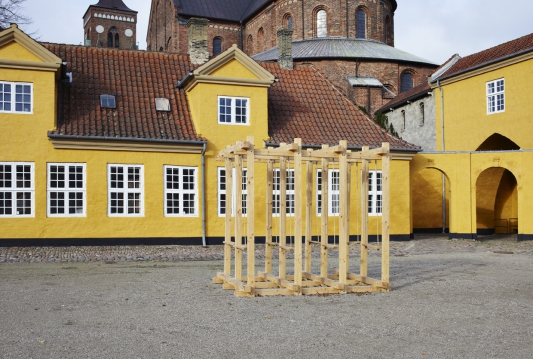Swings 2002




Swings (2002)
2020 Kunsthal 6100, Coordination Models at the main square, Haderslev, Denmark
2017 Randers Kunstmuseum, Spektakel Festival, Randers Denmark
2014 Statens Kunstfond 50 år, event: ”Stævne”, Ringkøbing, Denmark
2014 Wanås Konst, skulpturpark,, Sweden
2013 Museet for Samtidskunst ”ROCK AROUND THE WORLD”, Roskilde, Denmark
2002 Coordination Model, Swings, med 'Frederiksholms Kanal', Trapholt, Denmark
2002 Swing Seat Construcrion, Coordination Model, Swings, Art Parade /Kunstparade, Copenhagen, Denmark arranged and curated by Dorte Buchwald, Lone Bank, Christina Hamre and Tania Rau
Molly Haslund works with audience participation in the pieces Coordination Models, which is a number of modified devises designed to challenge the participants. Familiar objects like skipping ropes, hopscotch frames and swings are integrated in various kinds of utility systems, where coordination and collaboration between the individual participants becomes imperative. The individual participant’s motor skills are challenged as well as their ability to coordinate group movements in order to make the systems in the coordination models work. When this succeeds a common rhythm is generated that transforms the utilities from commonplace play objects to complex collaboration modules, where the individuals and the group are dependent on each other.
Swings is Haslund’s first coordination model and was her contribution to the Copenhagen Art Parade (Kunstparade 2002). Swings consists of a large wooden frame made of unprocessed timber holding two rows of swings, four in each, situated so close that people must swing in unison in order not to collide. The Art Parade was hosted by Lone Bank, Christina Hamre, Dorthe Buchwald and Tanja Rau from the The Royal Academy of Fine Art (DK) and started in the Charlottenborg Courtyard and crossed the city of Copenhagen to the Enghave Park in the Vesterbro district. The parade stopped off on centrally located Nytorv/ Gammeltorv and at Skt. Hans Torv in the Nørrebro district. The Swing Seat Constriction was utilised on these locations. A team of six people wearing yellow hats lowered and raised the swing on a big trolley that transported the swing during the parade. Swing Seat Construction and a slow-motion documentation video of the parade was shown at the Konglomerat at Trapholt.
Rock Around the World
MOCA Museum of Contemporary Art, Roskilde
September 21st–December 15th 2013
''Some objects are daring and dangerous others almost impossible, they are just difficult to make work. In order to use the skipping ropes teams must be formed and practice is required some time before starting to obtain the ultimate usage. The possible encounters and opportunities for sharing are clearly central to the piece but the time when people imagine what might happen is just as important. There is quite a long way to go before the optimal use of the objects can be achieved, unless you are lucky enough to be present at the right time with the right people, or are able arrange a whole lot for it to happen. So the actual idea of how things can be optimally used and the sharing become the significant core.''
''The skipping ropes and hopscotch and the swings have never been displayed together before. They were all created for various exhibition contexts over the last ten years. The fact that they don’t figure alone integrates them even more; it’s definitely different when they are presented as a series, where the relationship enhances the individual statements.''
''All the works relate in an active way to the concept of imagining possibilities and limitations of physical, contemplative, individual, mental and social space. They possess social connections as an immediate option but loneliness is also present and there is even an evil side to them, which can appear quite fast and get out of hand. Paradoxically the works seem to provoke both directions and you must decide what you’d like to get out of them, and how far you will go. So there will be a clash between what you see, between the idea of the object’s function and what actually happens, what the objects actually are''
Exerpts from interview with Anne K. Iversen
A swing……
In the summer of 2002 the exhibition ”Konglomerat” was shown at Trapholt presenting the sculpture students at the Royal Academy of Fine Art (…) For this exhibition Molly Haslund created a so-called “Coordination Model”; a large wooden frame holding two rows of swings – 8 in all - hanging so close that people needed to coordinate their swinging in order not to collide. The swing was made of unprocessed timber and appeared as a sculpture - also when unused. It was partly identifiable as a toy (that swings are) but it also became alienated within the museum framing. The close hanging of the swings and the frame itself created a defined and new space for the swings. It was not possible to experiment with the swings’ force of gravity, as a lack if control or coordination would result in collisions and accidents. In this way Haslund has created a piece that seems inaccessible and it poses a number of interesting and existential questions.
Extract of text by Karen Grøn, Trapholt 2002
Photographers Lea Nielsen, Molly Haslund, Ekspress